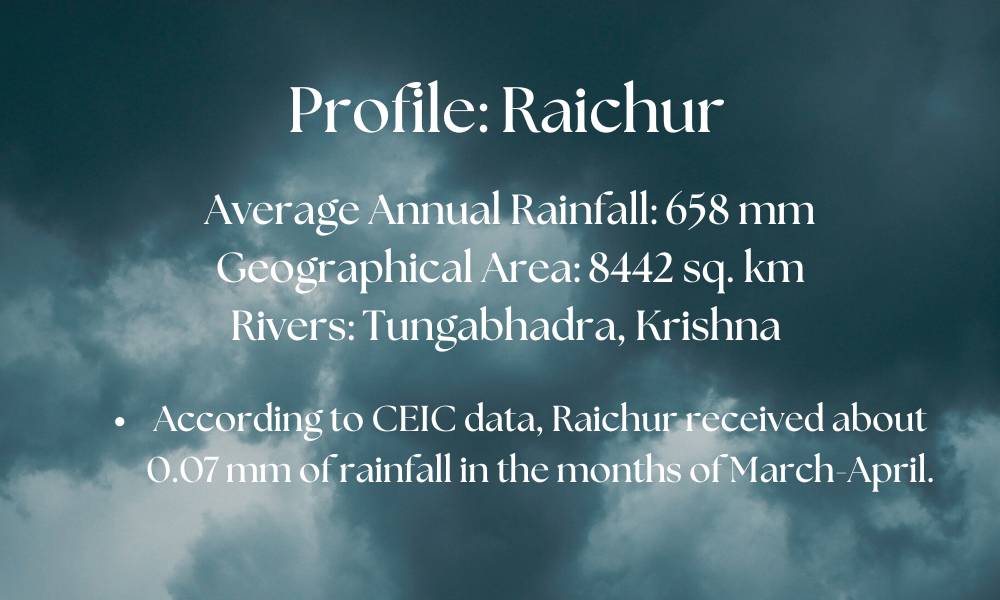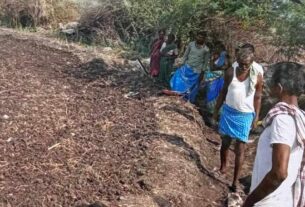Forest fires in Lingasugur Taluk have caused issues for not only the wild animals living in the range, but the people living nearby and the authorities as well.
Munna gets the fodder for his cows from the forests. Along with that, he also gets wood to light fire in the night, on which his wife cooks food for the family of four. The 55-year-old earns money from rearing his two cows, which he also takes to feed in the surrounding forests of Lingasugur, about two kilometres away. As he prepares himself to take his cows for feeding on one sunny day, the news of a forest fire near the field stops him that day.
The fire ignited in those forests from February to May made him suffer financially. He cannot take his cows to feed, nor get fodder for them. He blames a lot of things for the forest fires that cause him loss, and one of them is farmers burning waste produce near the protected forest cover.
Munna is one of the dairy farmers living in Lingasugur who depend on the forests nearby to feed their cows, and while their losses are not much, said that the major causes of forest fire in Lingasugur are man-made.

Situated about 20 km away from Krishna River, the scrub and thorny forests of Lingasugur harbour several wild animals and birds. Golden jackal, Indian fox and the blackbuck antelopes are some of the widely spread species across the forest cover. The forest fires in Lingasugur take the lives of about 40 blackbucks and foxes every year, according to the Social forestry range department. The department expressed that flames of the forest fire in Lingasugur could spread as far as 150 acres, or 0.6 sq km of land from the starting point, destroying every ecosystem that could have been present there.

The forest fires take the lives of about 80 to 100 species of wild animals present in forests of Karnataka, including mammals, reptiles and birds. Kumar Pushkar, Additional Principal Chief Conservator of Forests (Wild life), said, “While we cannot give an exact number of wild animals that die in forest fires every year, it is sure that the number is in thousands.”
Dr. T. Ganesh, senior fellow at Ashoka Trust for Research in Ecology and the Environment, said that forest fires are a big threat to the wildlife in the Taluk. “A fire ignited for whatever reason could cause a huge impact to the fauna. While there is still availability of statistics regarding number of mammals killed in forest fire, the harm to the birds would be on a much wider scale.” The forests in Raichur also harbour a large number of bird species, including the Red-collared dove, Indian Robin and Black-tailed Godwit. Ganesh said that the fires put many species of wild animals under threat of endangerment.
“People throw cigarette butts in the forests nearby after smoking, which ignites the fire. Since it is a very dry forest, it is easy for the bushes to catch fire,” Munna said, “Farmers who cannot manage their waste they have from the agricultural produce of the year also put them to fire near the forest cover.”
About 20.19 percent of Karnataka’s geographical area is covered under forests. Out of which, Raichur has about 8,386 sq. km of forest in the district, about 3.9 percent of the forest cover of the entire state.
The Forest Survey of India’s report named “Indian State of Forests Report” (ISFR) about the forest cover of different states in 2021 showed that Karnataka has about 38, 730 sq. km of forest cover, out of which 4,611 sq.km of area is covered in shrubs. Shrubs are defined as forests which has canopy density lesser than 10 percent, part of which is present in Lingasugur range of Raichur. The same report of ISFR also showed that about 9 percent of the forest cover in Karnataka is highly fire-prone and about 17 percent of forest cover is moderately prone to fire.
The peak season of forest fires starts in January, and stays throughout the summer season. According to statistics by Global Forest watch, there were about 14,811 Visible Infrared Imaging Radiometer Suite (VIIRS) alerts of forest fires in Karnataka in 2024 till now. Raichur district had reported more than 757 VIIRS alerts of forest fires in 2024.
Vijay Kumar, deputy forest range officer of the Lingasugur division blames forest fire on farmers burning their waste material near the protected forests. “Even a little ignited spark causes fire on a large scale. The trees planted are mainly shrubs, which have growth of about 2 feet, making it very easy to catch fire and the dryness makes the fire grow farther, as far as 150 acres.”

Kumar said that the social forestry range spend about Rs. 1.5 to 2 lakh each year on putting new plantations in the protected forest, in about 200 hectares of the Lingasugur range. The fire spreads as far as 60 hectares of the plantations every year.
He added that this issue is not a recent occurrence. “It has been going on as long as 15 years ago. The farmer burns waste, forest catches fire, and we have to deal with damage. The only thing that did not change was the equipment that we use. We still don’t have enough funds to buy the new equipment.”
The forest division of Lingasugur is divided into three parts: the Territorial forest division, the Social forestry range, and the Watershed department. The social forestry range deals with the relationship between the people and forest, which Kumar said, “makes us witness more causes of forest fires.”
Dealing with the fire
The dry and hot land of Amareshwara, one of the villages surrounded by forests in Lingasugur, was heating up in the sun on a weekday in February. Only three to four people could be seen at once on the path of Amareshwara temple, while the shopkeepers decided to keep themselves under the shelter because of the sun directly on their faces.
The forest near the temple was dry, consisting of brown and light green trees spanning across the hill where the temple was situated in. Near the dividing wall of the temple and the forest, was a freshly burnt out pit of fire. The black ashes settled down on the ground, while the smoke was still blowing with the wind.
Mounesh, seller of sugarcane juice to the travellers of the temple said the forest fire does not affect their life to a larger extent, though he has witnessed people putting their wastes on fire which catches up to bigger fires in the forest. He said that the pit of fire burnt on the place was someone nearby putting their waste on fire.

“The small fire pits you see on boundaries of fields or like that? It is either people burning waste or making boundaries near their areas, but it’s mostly waste only,” he said.
Lingasugur is abundant in crops like paddy, Bajra, sunflower, groundnut and red gram. Straws and husk are common waste by-products from these crops, which is used as fodder and other works. “The rest of it, is burnt. The problem lies in the location of burning waste, and the ground problem is the education of waste management to these farmers,” Dr. Raghav S. Gowda, professor from University of Agricultural Sciences, said.
There are four ranges of forest in Raichur division: Manvi, Deodurga, Raichur and Lingasugur ranges. The Lingasugur sub-division spans across the Lingasugur town to places like Amareshwara, Sarjapura and Maski. The forests in this region are divided into reserved forests, protected forests, village forests and government lands. The Indian forest Act, 1927 gave state governments the power to declare any forest-land or waste-land which is the property of the Government as reserved forests. The Karnataka Forest Act, 1967 took the idea further. Most of the parts of the forest cover near Lingasugur Taluk are parts of protected forests by the social forestry range, according to Kumar.
While the forest cover is huge, Kumar said that their workforce is much less. “We have forest watchers deployed at parts of the cover. But we cannot place forest watchers on every nook and cranny, we don’t have enough people,” he added. The social forestry range has about 13 forest watchers across the forest covers of Lingasugur.
To deal with this, he said that the social forestry range deploys people from villages nearby. “We have people in the nearby villages of forests we can put forest watchers in, so they can tell us whenever a forest fire happens. It has worked for us to monitor forest fires, but not always.”
Karnataka forest rules, 1969 states “no person shall kindle any fire or leave any fire burning upon any public or private road or path which adjoins or passes through a reserved forest or protected forest or district forest but does not form part of such forest.” The rules also state that no fire should be ignited within or near a protected or reserved forest area from November 1 to June 30. According to Kumar, if caught, the culprit has to serve sentence of about three to four years in jail.
Kumar said that the procedure for them is to only catch if they find a culprit, and notify the Territorial forest department of Lingasugur division, which takes action against them legally. “But we know the person has done that without any knowledge of where he should burn or where he shouldn’t. The person is poor with a family to feed, it is not fair that we put them under arrest for a long time,” he said, “so we leave them with a warning unless we can figure it was deliberate.”

While Kumar feels helpless with the forest fires, he said that the social forestry range has been able to take care of about 60 percent of the forest fires. “We have water guns which throw water when a forest fire occurs. By 2019, we only had two of those, and had to borrow fire engines from the fire department. Afterwards, we pooled money amongst ourselves and bought three more guns. The action, on the contrary, made more holes in our pockets than helping with the fire.”
Kumar proposes a probable solution of giving more workforce to the department so they could handle the fires better.
Munna also thinks there is a way to tackle man-made causes of forest fires. He said, “I think most of the farmers are not educated about how to manage the waste, so they think burning is the best solution. If they knew more about how to manage it, they would not go burn it. Same with people who throw cigarette butts. People should be taught not to do such things, or they would be among the people to have issues when a forest catches a fire.”














